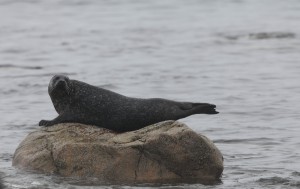 Grey seals have been in the news recently for two very different reasons. On the positive side is that studies have now shown that they benefit from offshore windfarms. The idea is that the structures of the windfarms actually under the water are creating artificial reefs where more fish, crabs etc. gather. Tagging of grey seals and, to a lesser extent, harbour seals, formerly known as common seals, has shown the correlation. With all the adverse publicity about windfarms, both onshore and offshore, and wildlife, it makes a change to see a more positive angle. However, somehow it seems strange to think of grey seals searching out windfarms or following pipe lines to find such a food source. Presumably it makes no difference to the grey seal where the cache of food came from!
Grey seals have been in the news recently for two very different reasons. On the positive side is that studies have now shown that they benefit from offshore windfarms. The idea is that the structures of the windfarms actually under the water are creating artificial reefs where more fish, crabs etc. gather. Tagging of grey seals and, to a lesser extent, harbour seals, formerly known as common seals, has shown the correlation. With all the adverse publicity about windfarms, both onshore and offshore, and wildlife, it makes a change to see a more positive angle. However, somehow it seems strange to think of grey seals searching out windfarms or following pipe lines to find such a food source. Presumably it makes no difference to the grey seal where the cache of food came from!
On the other side of the coin is increasing evidence that more grey seals are being shot than the legal licences issued by the government indicate. Recent shooting of grey seals a long way from any fish farms are evidence. It must have been a shock for people to find the dead grey seals. Official licences to protect fish, mainly where fish farms are concerned, are issued each year and, under these licences, a few hundred seals shot. However, unfortunately people do not take legal preventative measures to deter the grey seals before the damage starts. Then the seals are illegally shot. Then there is the element of people who shoot the seals when they are some distance from the fish farms which is, of course, illegal but it continues unabated in many areas.
Historically the grey seal has always been killed in large numbers and the main reason was not their so called damage to fish stocks. A dead grey seal was useful for many reasons and very few parts of them were not utilised in some way. One use was for oil lamps and their meat was considered at one time to be a valuable resource. In those days if you lived on one of the smaller islands, which many people did, then the grey seals was almost a survival necessity. The skins were used for waterproofs, rubber boots and a good barter commodity to other people. Even the great rookery, as the breeding and pupping sites are called, on the Monach Isles in the Hebrides, was so devastated by the numbers being taken that it was thought the formerly huge colony of several thousands were in danger of extinction. At one time, around 1914, such was the killing in so many places that it was thought there were only 500 grey seals left in the whole of Britain. Although this was a drastic under-estimate, legislation was brought in to protect the grey seal and in one form or another has continued until this day.
If you now want to see grey or harbour seals then it has never been easier. Driving a few miles around Inverness can enable you to see both. Last week was a good example as I drove over the Cromarty bridge and turned eastward. A few hundred yards along the main road there is a layby on the right and I just stopped and used the car as a hide to watch harbour seals hauled out. These seals in Cromarty Firth have recently been legally protected from disturbance although I am not sure what that means in practice. Perhaps people walking out on the mudflats from the layby have disturbed them as the majority of seals on my visit were way out on a mud bank in the centre of the firth. Next week we shall look at the enormous grey seals and where to see them locally.
Tags: highland wildlife
